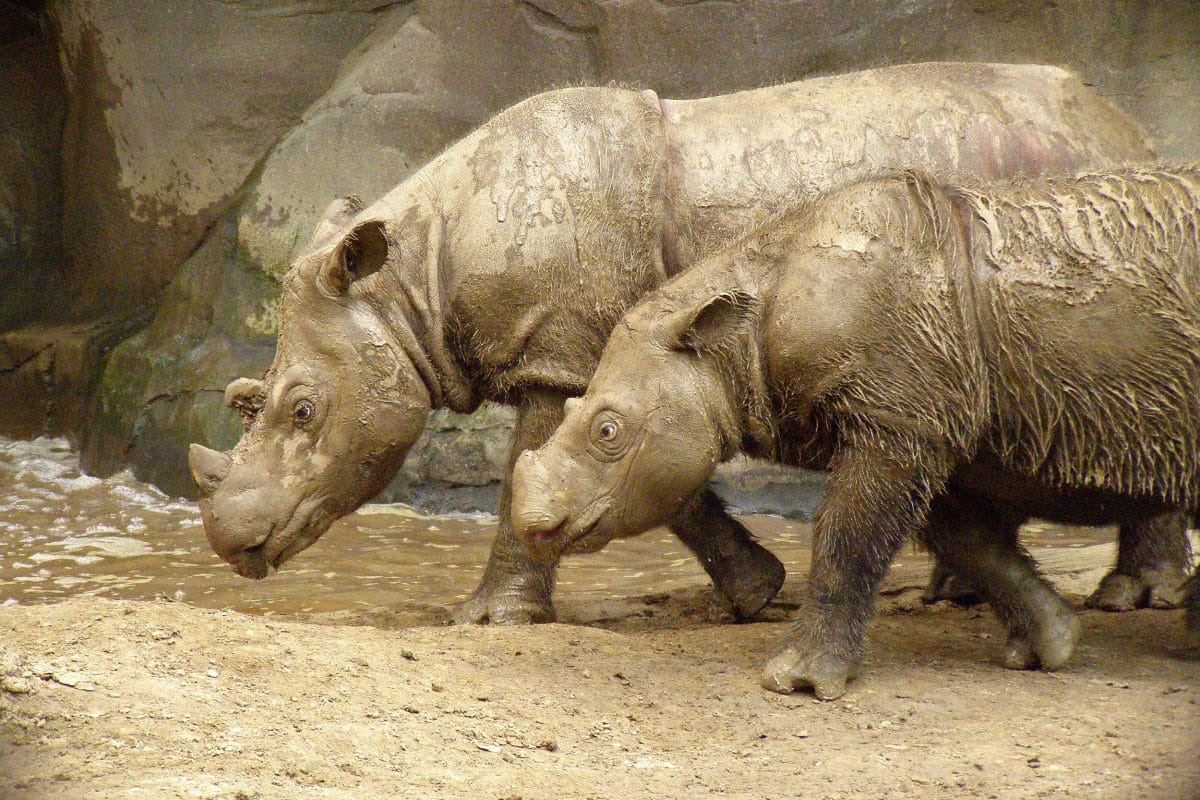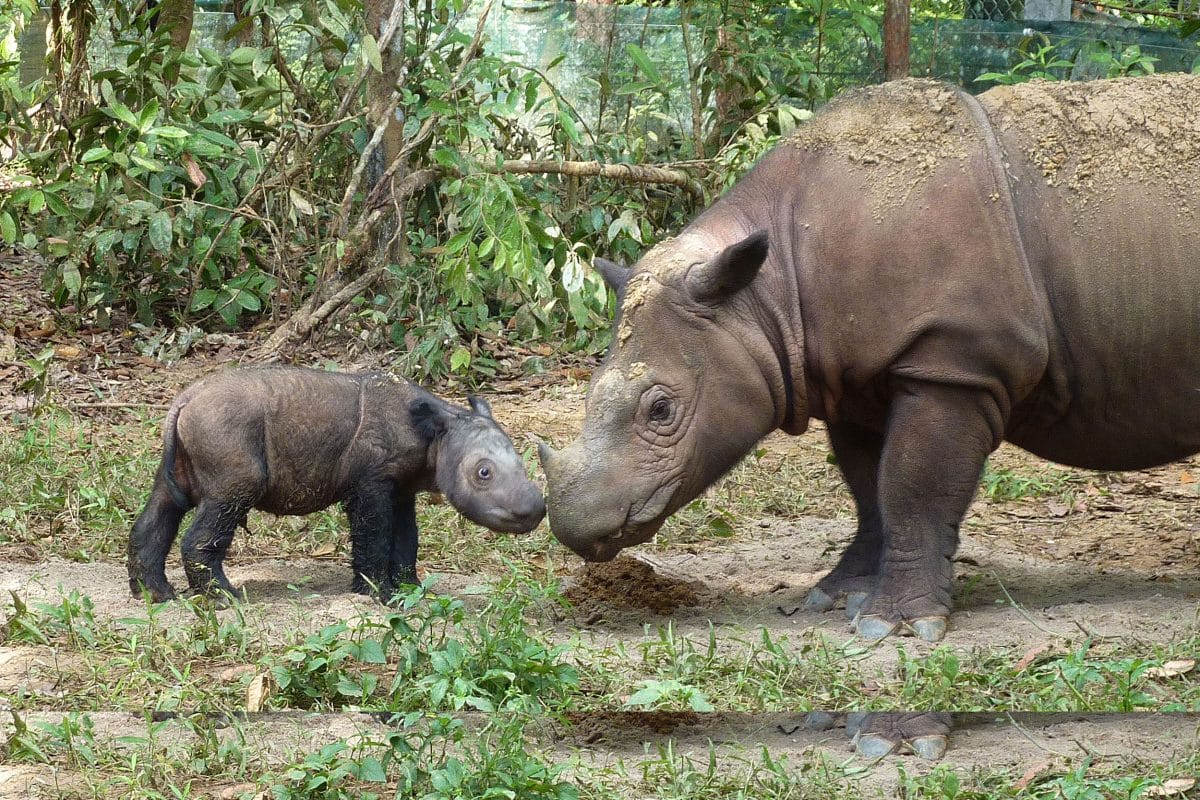Countless species are being driven to extinction by both deliberate and accidental human activity, but extinction is not something we invented. Nature has been selecting species for the bin for hundreds of millions of years. The story of the Sumatran rhino’s demise has a big hairy foot in both of these pies. Whilst the biggest threats to their continuation on the planet are poaching and habitat loss, Mother Nature also seems to be holding up a red card.
Less than 100 Sumatran rhinos made it to see-in the year 2016. Malaysia now has a wild rhino population of zero, and only three in captivity. Indonesia is fairing slightly better but around 90 individuals is far from a healthy population for a planet the size of ours. The last expat Sumatran rhino, called Harapan (meaning Hope), lived in Cincinnati Zoo but was relocated to Sumatra in 2015.
And with that heavy-laden trans-Pacific flight, no Sumatran rhinos existed outside of Indonesia or Malaysia.

Mean Old Mother Nature
If you’ve ever had trouble with romance (who hasn’t), Sumatran rhinos can definitely empathise.
As a species they are secretive and solitary, and so if two should have the very good fortune of running into each other in the forest (given how rare they are, the chances are automatically low), the first response would likely be aggression. Even if it’s a male and female and the circumstantial rendezvous has potential for the pitter-patter of tiny three-toed feet, the meeting is still likely to rapidly descend into biting and sparring.
With most animal species, when a male or female is ready to ‘settle down’ (if only for five minutes or so) there will be displays of courtship, nest making, or physical signs on/in the body that the time is right. But for Sumatran rhinos, romance is a bore and little if any flirtatious behaviour exists to let the other rhino know of their intentions. An approaching member of the opposite sex is as likely to horn you in the ribs as to ask for your number.

Why does Mother Nature make it so hard for them? Ahhh, she’s not even done there I’m afraid.
Sumatran rhinos are induced ovulators. This means that a female needs to mate in order for her body to wake up and begin to prepare itself for making a baby, and thus she needs to mate again to actually conceive. By which time, the one and only male rhino that has come along in the last six months is long gone, probably for at least another six months.
In species that are induced ovulators, if ovulation does not occur relatively regularly, cysts will start to grow in the womb which can cause real problems when trying to produce offspring. What this basically means is that even if a female Sumatran rhino finds a mate in the wild, she probably won’t conceive anyway.
Intervention of a Good Kind
In the 1980s, rhino specialists (the only job title I want besides my own) put their qualified heads together and agreed a captive breeding programme should be initiated (hence the aforementioned departure of Harapan from Cincinnati Zoo).
So began the Sumatran Rhino Sanctuary (SRS) in Indonesia where rhinos live in a semi-wild (but heavily guarded) area of Way Kambas National Park. A number of highly skilled, extremely motivated, and well-armed individuals called the Rhino Protection Unit protect this crash (collective noun for rhinos) from poachers.
The most recent birth at the SRS was that of a little girl in May 2016, and boy oh boy is she a cutie.

The short-term goals of the SRS are to produce as many mini rhinos as possible, as well as to increase our knowledge of their biology and behaviour. The long term goal (best case scenario) is to release a healthy population of rhinos back into the wild.
However, this obviously requires humankind embarking on a new age of global enlightenment regarding traditional medicines, meaning each released rhino won’t walk their horn straight into a poacher’s duffel bag if left un-guarded.
But with education on the rise, and Prince William on their side, we can still hope for this future.
References
- Hance, J. (2015). Officials: Sumatran rhino is extinct in the wild in Sabah. [Online]. Available at: https://news.mongabay.com/2015/04/officials-sumatran-rhino-is-extinct-in-the-wild-in-sabah/ [Accessed 16th September 2016]
- Payne, J. (2016). Tragic death of Sumatran Rhino points to the need for a single species recovery programme. [Online] Available at: http://www.borneorhinoalliance.org/resources/comment/tragic-death-of-sumatran-rhino-points-to-the-need-for-a-single-species-recovery-programme/ [Accessed 14th September 2016]
- Save the Rhino (2015). Sumatran rhino Harapan embarks on new life in Indonesia. [Online] Available at: https://www.savetherhino.org/latest_news/news/1374_sumatran_rhino_harapan_embarks_on_new_life_in_indonesia [Accessed 21st September 2016].
- Save the Rhino (No date). Indonesian Sumatran Rhino Sanctuary. [Online] Available at: https://www.savetherhino.org/asia_programmes/sumatran_rhino_sanctuary_indonesia [Accessed 16th September 2016].
- Save the Rhino (No date). Indonesia: RPU Programme. [Online] Available at: https://www.savetherhino.org/asia_programmes/rpu_programme_indonesia [Accessed 16th September 2016].
- Save the Rhino (No date). The challenges of breeding Sumatran rhinos. [Online] Available at: https://www.savetherhino.org/asia_programmes/sumatran_rhino_sanctuary_indonesia/the_challenges_of_breeding_sumatran_rhinos [Accessed 15th September 2016].
- Save the Rhino (No date). An heir and a spare. [Online] Available at: https://www.savetherhino.org/asia_programmes/sumatran_rhino_sanctuary_indonesia/stories_from_the_field/an_heir_and_a_spare [Accessed 21st September 2016].
- Schaffer, N. E., Zainal-Zahari, N. E., Suri, M. S. M., Jainudeen, M. R., and Jeyendran, R. S. 1994. Ultrasonography of the Reproductive Anatomy in the Sumatran Rhinoceros (Dicerorhinus sumatrensis). Journal of Zoo and Wildlife Medicine 25 (3): 337-348


